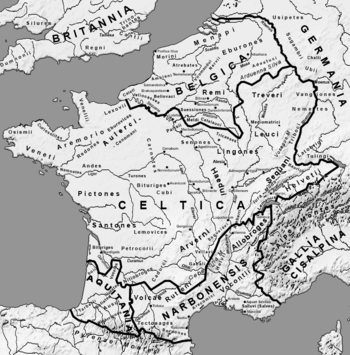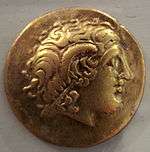Lingones

The Lingones were a Celtic tribe that originally lived in Gaul in the area of the headwaters of the Seine and Marne rivers. Some of the Lingones migrated across the Alps and settled near the mouth of the Po River in Cisalpine Gaul of northern Italy around 400 BC. These Lingones were part of a wave of Celtic tribes that included the Boii and Senones (Polybius, Histories ii.17). The Lingones may have helped sack Rome in 390 BC.
The Gaulish Lingones were thoroughly Romanized by the 1st century, living in a rich and urbanized society in the region of Langres and Dijon and minting coins, but getting caught up in the Batavian rebellion (69 AD), described by Tacitus.
The strategist Sextus Julius Frontinus, author of the Strategematicon, the earliest surviving Roman military textbook, mentions the Lingones among his examples of successful military tactics:
| “ | In the war waged under the auspices of the Emperor Caesar Domitianus Augustus Germanicus and begun by Julius Civilis in Gaul, the very wealthy city of the Lingones, which had revolted to Civilis, feared that it would be plundered by the approaching army of Caesar. But when, contrary to expectation, the inhabitants remained unharmed and lost none of their property, they returned to their loyalty, and handed over to me seventy thousand armed men. | ” |
Their capital was called Andematunnum, then Lingones, now Langres in the Haute-Marne, France. It was built on a rocky promontory above the Marne River, and still preserves some of its medieval fortifications, which afford panoramic views of the Marne Valley, the Langres plateau and the Vosges. The Cathedral St-Mammes, built in the Burgundian Romanesque style for the ancient diocese that was referred to as Lingonae ("of the Lingones") and rivaled Dijon. Three of its early bishops were martyred by the invasion of the Vandals, about 407.
In Roman Britain, two cohorts of Lingones, probably subscripted from among the Lingones who had remained in the area of Langres and Dijon are attested in the 2nd and 3rd centuries, from dedicatory inscriptions and stamped tiles.
See also
External links
- Livius.org: Lingones
- Livius.org: Lingones in the Batavian revolt
- Second Cohort of Lingones in Roman Britain
- (Italian) Lingones in Italy
